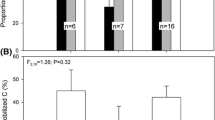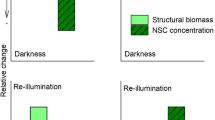Abstract
Four biennial species (Arctium tomentosum, Cirsium vulgare, Dipsacus sylvester and Daucus carota) which originate from habitats of different nutrient availability were investigated in a 2-year experiment in a twofactorial structured block design varying light (natural daylight versus shading) and fertilizer addition. The experiment was designed to study storage as reserve formation (competing with growth) or as accumulation (see Chapin et al. 1990). We show that (i) the previous definitions of storage excluded an important process, namely the formation of storage tissue. Depending on species, storage tissue and the filling process can be either a process of reserve formation, or a process of accumulation. (ii) In species representing low-resource habitats, the formation of a storage structure competes with other growth processes. Growth of storage tissue and filling with storage products is an accumulation process only in the high-resource plant Arctium tomentosum. We interpret the structural growth of low-resource plants in terms of the evolutionary history of these species, which have closely related woody species in the Mediterranean area. (iii) The use of storage products for early leaf growth determines the biomass development in the second season and the competitive ability of this species during growth with perennial species. (iv) The high-resource plant Arctium has higher biomass development under all conditions, i.e. plants of low-resource habitats are not superior under low-resource conditions. The main difference between high- and low-resource plants is that low-resource plants initiate flowering at a lower total plant internal pool size of available resources.
Similar content being viewed by others
References
Ågren GI (1985) Theory for growth of plants derived from the nitrogen productivity concept. Physiol Plant 64:17–28
Chapin FS III, Schulze ED, Mooney HA (1990) The ecology and economics of storage in plants. Annu Rev Ecol Syst 21:423–447
Cyr DR, Bewley JD (1990) Seasonal variation in nitrogen storage reserves in the roots of leafy spurge (Euphorbia esula) and responses to decapitation and defoliation. Physiol Plant 78:361–366
Ellenberg H (1978) Vegetation Mitteleuropas mit den Alpen in ökologischer Sicht. Ulmer, Stuttgart pp 982
Fichtner K, Schulze ED (1992) The effect of nitrogen nutrition on growth and biomass partitioning of annual plants originating from habitats of different nitrogen availability. Oecologia 92:236–241
Handel E van (1967) Determination of fructose and fructoseyielding carbohydrates with cold anthrone. Anal Biochem 19:193–194
Heilmeier H, Schulze ED, Whale DM (1986) Carbon and nitrogen partitioning in the biennial monocarp Arctium tomentosum Mill. Oecologia (Berlin) 70:466–474
Ingestad T, Agren GI (1992) Theories and methods on plant nutrition and growth. Physiol Plant 84:177–184
Jong TJ de, Klinkhamer PGL, Nell HW, Troelstra SR (1987) Growth and nutrient accumulation of the biennials Cirsium vulgare and Cynoglossum officinale under nutrient rich conditions. Oikos 48:62–72
Lambers H, Freijsen N, Poorter H, Hirose T, Wef A van der (1989) Analyses of growth based on net assimilation rate and nitrogen productivity. Their physiological background. In: Lambers H, Cambridge ML, Konings H, Pons TL (eds), Causes and consequences of variation in growth rate and productivity of higher plants. SPB Academic Publishing by The Hague, Netherlands. pp 1–17
Meusel H (1952) Über Wuchsform, Verbreitung und Phylogenie einiger mediterranmitteleuropäischer Angiospermen-Gattungen. Flora 139:333–393
Meusel H, Kästner A (1990) Lebensgeschichte der Gold- und Silberdisteln. Österreichische Akademie der Wissenschaften. Math-Naturwiss.Klasse Bd 127:1–194
Millard P (1988) The accumulation and storage of nitrogen by herbaceous plants. Plant Cell Environm 11:1–8
Mossé J (1990) Nitrogen to protein conversion factor for ten cereals and six legumes or Oilseeds. A reappraisal of its definition and determination. Variation according to species and to seed protein content. J Agric Food Chem 38:18–24
Orians HG, Solbrig OT (1977) A cost-income model of leaves and roots with special reference to arid and semiarid areas. Am Nat 111:677–690
SAS Institute Inc (1985) SAS/STAT User's Guide: Statistics, Version 5 edition. Cary, N.C.: SAS Institute Inc
Schurr U, Gebauer G (1990) Aminosäureanalyse mit OPA-Vorsäulenderivatisierung. Kontron Hausmitteilungen
Strauch L (1965) Ultramikro-Methode zur Bestimmung des Stickstoffs in biologischem Material. Z Klin Chem 3:165–167
Author information
Authors and Affiliations
Rights and permissions
About this article
Cite this article
Steinlein, T., Heilmeier, H. & Schulze, ED. Nitrogen and carbohydrate storage in biennials originating from habitats of different resource availability. Oecologia 93, 374–382 (1993). https://doi.org/10.1007/BF00317881
Received:
Accepted:
Issue Date:
DOI: https://doi.org/10.1007/BF00317881




